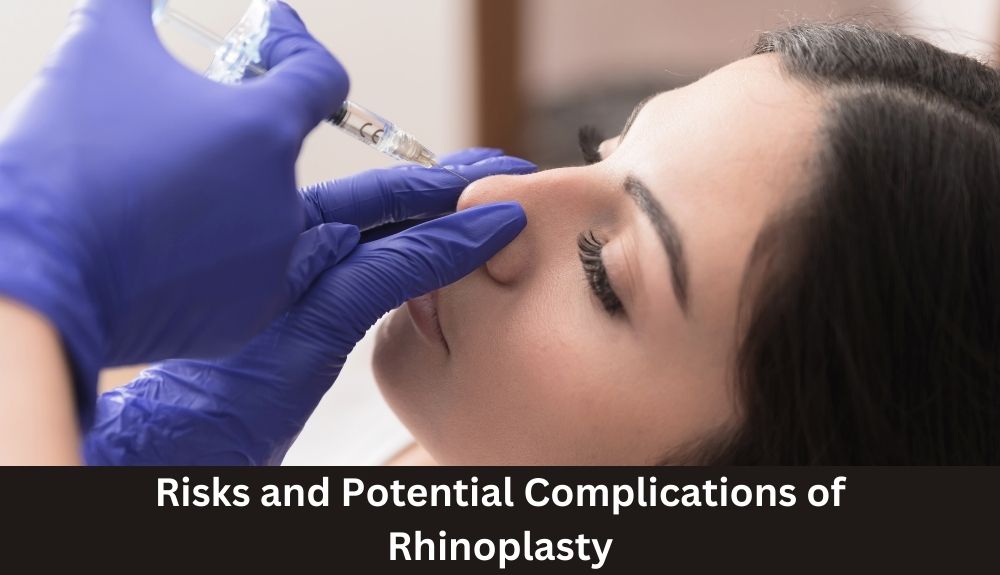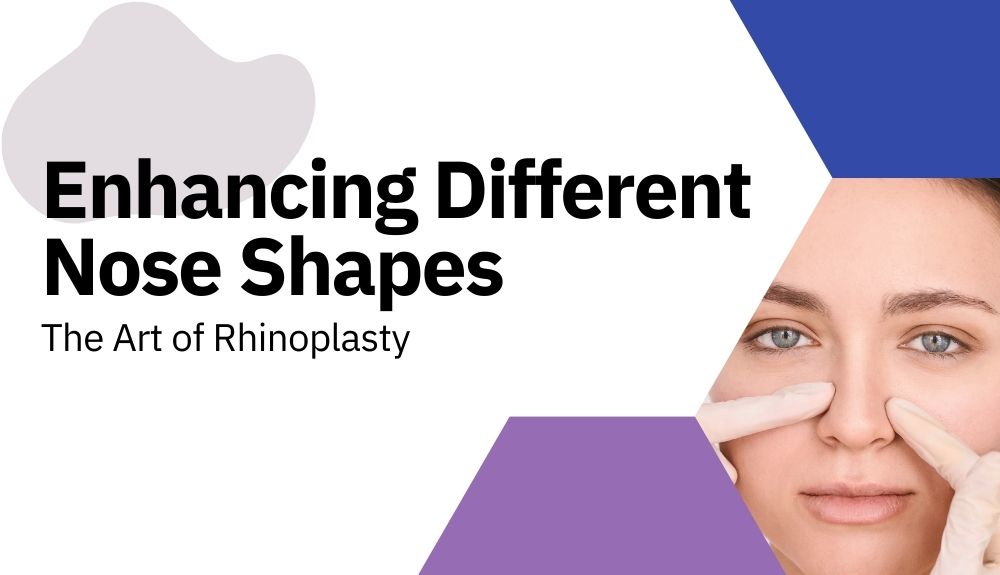Are you unhappy with the shape of your nose? Do you dream of a more balanced and harmonious facial appearance? Look no further than the world of rhinoplasty, where skilled surgeons can enhance and transform different nose shapes to bring out your true beauty. In this blog, we will explore the art of rhinoplasty and how it can help you achieve the nose of your dreams.
Throughout this informative article, we will dive deep into the various nose shapes and how they can be enhanced through rhinoplasty techniques. Whether you have a prominent hump on your nose, a bulbous tip, a crooked nose, or any other concern, we’ve got you covered. We’ll discuss the potential causes behind different nose shapes, the aesthetic goals you can achieve through rhinoplasty, and the procedures that can bring those transformations to life.
1. Understanding Rhinoplasty
Rhinoplasty, also commonly known as a “nose job,” is a surgical procedure aimed at enhancing and reshaping the nose. It is a highly sought-after cosmetic procedure that can address various concerns related to the shape, size, and overall appearance of different nose types. This section will provide you with a comprehensive understanding of rhinoplasty and the different nose shapes it can enhance.
1.1 What is Rhinoplasty?
Rhinoplasty is a surgical procedure performed by a qualified plastic surgeon to modify the size, shape, and proportions of the nose. It is often used to address cosmetic concerns or improve nasal function. The procedure involves making incisions, manipulating the nasal bone and cartilage, and repositioning or reshaping the tissue to achieve the desired results.
1.2 Common Nose Types
The human nose comes in various shapes and sizes, each having unique characteristics. Let’s explore some of the common nose types that rhinoplasty can enhance:
1.2.1 Roman Nose
The Roman nose, also known as the aquiline nose, is characterized by a prominent and slightly curved bridge. Rhinoplasty can help reduce the prominence of the bridge and create a more balanced and proportionate appearance.
1.2.2 Straight Nose
Straight noses have a minimal curve or hump along the bridge. Rhinoplasty can refine the nasal bridge, making it smoother and more harmonious with other facial features.
1.2.3 Greek Nose
Greek noses have a straight bridge that gently slopes down to the tip. Rhinoplasty can address any irregularities, refine the shape, and enhance the overall symmetry of the Greek nose.
1.2.4 Nubian Nose
Nubian noses are characterized by a broad base and a thick, fleshy tip. Rhinoplasty can reduce the bulkiness, refine the tip, and bring a more balanced and aesthetic appearance to the Nubian nose.
1.2.5 Button Nose
Button noses refer to petite and slightly upturned noses with a small size and a round tip. Rhinoplasty can enhance the definition of the tip, elevate the nasal bridge, and create a more refined and delicate appearance.
1.2.6 Hawk Nose
Hawk noses, also known as hooked noses, have a significant downward curvature at the tip. Rhinoplasty can address the curvature, reduce the prominence.
2. Different Nose Shapes
Our noses come in various shapes and sizes, each with its own unique characteristics and features. Understanding the different nose shapes can help individuals better identify their own nasal structure and explore the possibilities of enhancing their appearance through rhinoplasty. Let’s take a closer look at some common nose shapes:
1. Roman Nose
A Roman nose, also known as a hooked nose, is characterized by a prominent bridge and a downward-curved tip. This nose shape often gives the face a strong and distinguished appearance.
2. Straight Nose
A straight nose is characterized by a smooth and even bridge, with a straight nasal dorsum. It presents a balanced look and is often considered as an aesthetically pleasing nose shape.
3. Greek Nose
The Greek nose, also known as an aquiline nose, has a gently arched bridge and a narrow tip. This nose shape is reminiscent of the statues of ancient Greek gods and goddesses.
4. Nubian Nose
The Nubian nose is characterized by a broad base and a wider bridge. It has a distinct and beautiful shape that is often associated with African heritage.
5. Button Nose
The button nose is characterized by a small and slightly upturned tip. This nose shape adds a cute and youthful charm to the face.
6. Snub Nose
The snub nose, also known as an upturned nose, features a slightly upturned tip. It creates an endearing and cheerful look.
3. The Importance of Nose Shape in Facial Aesthetics
When it comes to facial aesthetics, the shape of the nose plays a significant role in defining a person’s overall appearance. Whether it’s a Roman nose, a Greek nose, a snub nose, or any other type of nose, each shape contributes to the unique beauty and balance of one’s face.
Understanding the impact of different nose shapes is crucial for individuals considering rhinoplasty, a surgical procedure aimed at enhancing the appearance and functionality of the nose. Let’s explore why nose shape is an important consideration in facial aesthetics:
1. Defining Facial Symmetry:
A well-proportioned nose enhances facial symmetry, which is considered a key factor of attractiveness. The bridge of the nose acts as a central focal point, and its shape should harmonize with other facial features to create a balanced overall look. Rhinoplasty enables plastic surgeons to reshape the nose, creating a more symmetrical and harmonious facial appearance.
2. Impact on Facial Proportions:
Certain nose shapes, such as a bulbous nose or an upturned nose, can create an imbalance in facial proportions. A skilled nose surgeon can perform rhinoplasty to refine and reshape the nose, bringing it into better alignment with the rest of the facial features. By correcting any structural abnormalities, the surgeon can help achieve a more proportionate and aesthetically pleasing facial appearance.
3. Enhancing Facial Harmony:
The nose is often referred to as the “most prominent feature” of the face. Its size, shape, and structure significantly influence overall facial harmony. For instance, a fleshy or broad-based nose might overpower other delicate features, while a small and delicate nose may not provide enough definition. Rhinoplasty techniques can be tailored to address specific concerns and bring all the facial elements into harmonious balance.
4. Preserving Ethnic Identity:
Individuals from diverse cultural backgrounds often have distinct nose shapes that are integral to their ethnic identity. It is essential to work with a skilled plastic surgeon who understands the nuances and subtleties of different nose types, allowing them to perform rhinoplasty procedures that enhance the overall appearance while preserving the person’s unique ethnic characteristics.
5. Emotional and Psychological Well-being:
The appearance of the nose can significantly impact an individual’s self-confidence and self-esteem. Addressing aesthetic concerns through rhinoplasty can contribute to improved emotional well-being and overall satisfaction with one’s appearance.
4. Consultation Process for Rhinoplasty
When considering rhinoplasty, it is essential to undergo a thorough consultation process with a qualified and experienced plastic surgeon. This initial step in the journey towards enhancing your nose shape is crucial in ensuring a successful surgical procedure and achieving your desired results. Let’s delve into the key aspects of the consultation process for rhinoplasty.
1. Research and Choosing a Plastic Surgeon
Before scheduling a consultation, take the time to research and find a reputable plastic surgeon who specializes in rhinoplasty. Look for a surgeon who has extensive experience, positive testimonials, and a track record of successful nose surgeries. This will guarantee that you are in capable hands and increase the likelihood of achieving the desired outcome.
2. Discussion of Goals and Expectations
During the consultation, you will have the opportunity to discuss your goals and expectations with the plastic surgeon. Explain your reasons for considering rhinoplasty and the specific changes you would like to make to your nose shape. An experienced surgeon will listen attentively, evaluate your facial features, and provide professional advice based on their expertise.
3. Assessment of Nose Structure and Facial Harmony
The plastic surgeon will conduct a comprehensive assessment of your nose structure and analyze how it harmonizes with the rest of your facial features. They will examine the nasal bone structure, the bridge of the nose, the size of the nose (whether it’s small, broad, or bulbous), and the overall symmetry. This evaluation will help the surgeon determine the appropriate surgical techniques and approaches to achieve your desired nose shape.
4. Detailed Analysis and Explanation
The plastic surgeon will explain the various aspects of rhinoplasty, including the types of rhinoplasty procedures available and which one is most suitable for your specific case. They will walk you through the potential risks and complications associated with the surgery, as well as the expected recovery period. This detailed analysis will provide you with a clear understanding of the procedure and enable you to make an informed decision.
5. Physical Examination and Imaging
As part of the consultation, the plastic surgeon may perform a physical examination of your nose to assess the nasal bone, cartilage, and skin condition. They may also use advanced imaging technology to generate digital simulations, giving you a visual representation of the potential results. This can be a valuable tool in determining whether the proposed changes align with your expectations.
5. Surgical Techniques for Enhancing Nose Shapes
Achieving the desired nose shape and enhancing facial features can be achieved through various surgical techniques in rhinoplasty. Skilled plastic surgeons employ these techniques to address different types of nose shapes, ranging from Roman and Greek noses to button and snub noses. Let’s explore the surgical procedures commonly used to enhance different nose shapes.
1. Rhinoplasty for Roman Nose:
Roman noses are characterized by a straight nasal dorsum with a slight hump or hook at the bridge. To refine and enhance this type of nose, the plastic surgeon may perform dorsal hump reduction. This technique involves sculpting the bone and cartilage along the nasal bridge to reduce the prominence of the hump and create a more balanced and harmonious aesthetic.
2. Augmentation for Asian Nose:
Asian noses typically have a smaller size and lower nasal bridge. To achieve a more defined and elevated nasal profile, surgeons often employ augmentation procedures. These involve using implants or grafts, such as silicone or cartilage, to augment the bridge of the nose. This technique helps to achieve a more prominent and balanced look that complements the facial features.
3. Refinement for Bulbous Nose:
Individuals with bulbous noses often seek rhinoplasty to achieve a more refined and sculpted appearance. Plastic surgeons use various techniques to address this nose shape, including tip refinement and nostril reduction. Through careful reshaping and sculpting of the nasal tip and reducing the width of the nostrils, the surgeon can create a more defined and elegant nose structure.
4. Correction for Fleshy or Wide Nose:
People with fleshy or wide noses may desire a more streamlined and proportionate look. Surgical techniques, such as nasal bone narrowing and alar base reduction, are commonly employed to address this concern. These procedures involve reshaping and repositioning the nasal bones and narrowing the width of the nostrils, resulting in a more balanced and harmonious facial appearance.
5. Straightening for Deviated Nose:
Deviation in the nasal structure can cause functional and aesthetic concerns. Surgeons employ techniques such as septoplasty and osteotomy to correct a deviated nose. Septoplasty involves straightening the nasal septum, improving airflow and correcting any breathing difficulties. Osteotomy refers to the surgical technique of breaking and repositioning the nasal bones to straighten the nose’s external appearance.
6. Correcting a Deviated Septum and Improving Breathing

The structure and functionality of the nose play a vital role in our overall well-being. One common issue that can hinder proper nasal function is a deviated septum. A deviated septum occurs when the thin wall that separates the nasal passages, known as the septum, is misaligned or crooked. This can lead to breathing difficulties, snoring, sleep apnea, and chronic sinus infections.
Correcting a deviated septum is not only beneficial for improving breathing but can also enhance the aesthetic appearance of the nose. During a rhinoplasty procedure, a skilled plastic surgeon can straighten the nasal septum, allowing for better airflow and overall nasal functionality. The surgical procedure to correct a deviated septum is called septoplasty, and it focuses on realigning the nasal passages to improve breathing.
The Importance of Proper Nasal Functionality:
Having a well-functioning nose is essential for various reasons. It helps filter air, humidify it, and traps dust and bacteria, protecting our lungs from potential harm. Additionally, a properly functioning nose ensures adequate oxygen intake and proper ventilation of the sinuses, preventing issues such as congestion and chronic infections.
The Septoplasty Procedure:
Septoplasty is a surgical procedure that corrects a deviated septum. It usually takes place under general or local anesthesia, depending on the complexity of the case. The surgeon makes small incisions inside the nostrils to access the septum. They then carefully remove or reposition the obstructing cartilage or bone that is causing the deviation. The procedure aims to straighten the septum, allowing for improved airflow through the nasal passages.
Benefits of Septoplasty:
1. Improved Breathing: By straightening the deviated septum, septoplasty improves airflow through the nose, enabling easier breathing and reducing the risk of snoring, sleep apnea, and chronic sinus infections.
2. Enhanced Quality of Life: Correcting a deviated septum can significantly improve overall well-being. Once nasal breathing is improved, individuals may experience better sleep, increased energy levels, and reduced daytime fatigue.
3. Aesthetic Enhancement: In addition to functional improvements, septoplasty can also enhance the appearance of the nose. By aligning the septum, the external structures of the nose may appear more symmetrical and harmonious with the rest of the facial features.
7. Reshaping a Nasal Hump
A nasal hump, also known as a dorsal hump, refers to a raised prominence or bump on the bridge of the nose. This particular nose shape can often cause individuals to feel self-conscious or dissatisfied with their appearance. However, with the help of rhinoplasty, it is possible to reshape and enhance the nose to create a more balanced facial profile.
Understanding the Nasal Hump
The nasal hump is primarily a result of excess bone and cartilage along the bridge of the nose.
Some individuals may have a genetic predisposition to having a prominent nasal hump, while others may develop it due to trauma or injury.
The size and shape of the hump can vary from person to person, ranging from subtle to more pronounced.
Rhinoplasty Procedure
Rhinoplasty is a surgical procedure that addresses various aspects of the nose, including the nasal hump. During the procedure, a plastic surgeon carefully reshapes the nasal framework to achieve the desired aesthetic result. The steps involved in reshaping a nasal hump typically include:
1. Pre-Surgical Consultation: The patient meets with a qualified nose surgeon to discuss their concerns, goals, and medical history. The surgeon evaluates the patient’s nasal characteristics and determines the most suitable approach for the procedure.
2. Anesthesia: The patient will be administered either local or general anesthesia, depending on the complexity of the surgery and the patient’s preferences.
3. Incisions: The surgeon creates small incisions either inside the nostrils (closed rhinoplasty) or across the columella (open rhinoplasty). The choice of incision technique depends on the specific requirements of each case.
4. Nasal Hump Reduction: The surgeon carefully removes excess bone and cartilage from the nasal hump using specialized surgical instruments. This process is done with precision to ensure a natural-looking result.
5. Cartilage Reshaping: In some cases, the surgeon may need to reshape and reposition the remaining cartilage to achieve a harmonious balance between the nasal tip and the bridge.
6. Incision Closure: Once the necessary modifications have been made, the incisions are closed with sutures or dissolvable stitches.
7. Recovery and Results: Following the procedure, patients can expect initial swelling and bruising around the nose and eye area. Over time, the swelling will gradually subside, allowing the final results of the reshaped nasal hump.
8. Refining a Bulbous Nasal Tip
The bulbous nasal tip is a common concern for many individuals seeking rhinoplasty. This nose shape is characterized by a rounded and wide tip, which can create a less defined and disproportionate appearance. Fortunately, rhinoplasty surgery offers effective solutions to refine and enhance the bulbous nasal tip, providing patients with a more balanced and harmonious facial feature.
1. Understanding the Bulbous Nasal Tip
The bulbous nasal tip is caused by several factors, including excess cartilage, thick skin, and weak underlying support structures. These factors contribute to the lack of definition and round shape of the nasal tip. During rhinoplasty, a skilled plastic surgeon can address these issues to create a more refined and sculpted nasal tip.
2. The Rhinoplasty Procedure for Bulbous Nasal Tip
During the rhinoplasty procedure, the plastic surgeon will make careful incisions to access the underlying structures of the nose. They will then reshape the nasal cartilage, removing excess tissue and refining the tip to achieve the desired contour. In some cases, additional techniques such as cartilage grafting may be utilized to provide further support and definition to the nasal tip.
3. Personalized Approach for Optimal Results
Achieving optimal results with bulbous nasal tip refinement requires a personalized approach. Each individual’s nasal anatomy and aesthetic goals are unique, and a skilled plastic surgeon will take these factors into consideration when planning the surgical procedure. By understanding the patient’s desired outcome and carefully evaluating their nasal structure, the surgeon can tailor the approach to achieve the most natural and balanced results.
4. Recovery and Results
Following a rhinoplasty procedure to refine a bulbous nasal tip, patients can expect some swelling and bruising in the nasal area. These temporary side effects will gradually subside over several weeks, and the final results of the surgery will become more apparent as the healing process progresses. It is crucial for patients to follow their surgeon’s post-operative instructions and attend regular follow-up appointments to ensure a smooth recovery and optimal outcome.
💡 key Takeaway: Refining a bulbous nasal tip through rhinoplasty surgery is an effective solution to enhance the overall appearance of the nose.
9. Enhancing a Flat or Wide Nose
Having a flat or wide nose can affect one’s facial harmony and overall appearance. Luckily, with the advancement of modern cosmetic procedures like rhinoplasty, individuals can opt for enhancements to achieve a more balanced and refined nose shape. In this section, we will discuss the various techniques used by plastic surgeons to enhance a flat or wide nose, providing you with insights into the options available for achieving your desired results.
1. Understanding a Flat or Wide Nose:
A flat nose refers to a nasal shape with minimal curvature or projection, while a wide nose typically has a broad base or wide nostrils. Both types can impact the proportions of the face and may cause individuals to seek nose enhancements.
2. Rhinoplasty Procedure for a Flat or Wide Nose:
The rhinoplasty procedure for enhancing a flat or wide nose aims to create a more defined and balanced nasal structure. Here are some common techniques employed by plastic surgeons:
Nasal Augmentation: The surgeon might use cartilage grafts, such as from the septum or ear, to build up the nasal bridge, providing more height and definition.
Alar Base Reduction: To address a wide nose, the surgeon may perform an alar base reduction. This technique involves removing a small portion of skin and tissue from the base of the nose, narrowing its appearance.
Tip Refinement: In some cases, the nasal tip might also be addressed during rhinoplasty. The surgeon can reshape and refine the tip to create a more proportionate and aesthetically pleasing look.
3. Preparing for Rhinoplasty Surgery:
Before undergoing any surgical procedure, it is crucial to consult with a skilled and experienced nose surgeon. They will evaluate your specific case and discuss the best approach to achieve your goals. During the consultation, you can also address any concerns or questions you may have, ensuring you are well-prepared for the surgery.
4. Recovery and Expectations:
Following the rhinoplasty procedure, you can expect some swelling and bruising, which will gradually subside over time. It is essential to follow all post-operative instructions provided by your surgeon to ensure optimal healing and results. Remember that complete recovery can take several months, and it’s important to have realistic expectations about the final outcome.
10. Correcting Asymmetry and Crookedness
Correcting asymmetry and crookedness is one of the key goals of rhinoplasty surgery. Whether a result of genetic factors, trauma, or previous nasal procedures, asymmetry and crookedness can significantly impact a person’s appearance and self-confidence. In this section, we will explore how rhinoplasty can help address these issues and create a more balanced and harmonious facial profile.
I. Understanding Asymmetry and Crookedness
Asymmetry refers to the lack of symmetry between the two sides of the nose, where one side appears different in size or shape compared to the other. Crookedness, on the other hand, pertains to a deviation in the nasal alignment, where the nose is visibly twisted or leans to one side.
II. Causes and Factors
Asymmetry and crookedness can result from various factors, including:
1. Trauma or injury to the nose: Accidents or injuries can cause fractures or dislocation of the nasal bones, leading to a shift in the nasal structure.
2. Genetics: Some individuals are born with naturally asymmetric or crooked noses, often inherited from their parents.
3. Previous nasal surgeries: Previous rhinoplasty procedures or septoplasty surgeries may have resulted in asymmetries if not performed properly or if complications arose during the healing process.
III. Rhinoplasty Techniques for Correcting Asymmetry and Crookedness
1. Surgical procedures: A skilled plastic surgeon will assess the specific nature of the asymmetry or crookedness and develop a personalized surgical plan. Techniques may include:
a. Osteotomy: This procedure involves carefully cutting the nasal bones and repositioning them to correct deviations and align the nose.
b. Cartilage grafts: Additional cartilage, often harvested from the patient’s own body (such as the ear or rib), can be used to restore symmetry and enhance nasal structure.
c. Septoplasty: In cases where a deviated septum contributes to the asymmetry, septoplasty may be performed to straighten and improve the functional aspect of the nasal passages.
2. Non-surgical procedures: In some cases, non-surgical procedures such as dermal fillers can be used to correct minor asymmetry by adding volume to specific areas of the nose.
11. Postoperative Care and Recovery
Once the rhinoplasty procedure is complete, proper postoperative care and recovery are essential for ensuring the best results. This section will guide you through the important aspects of postoperative care, including what to expect during the recovery period and how to promote healing.
1. Follow your surgeon’s instructions: Your plastic surgeon will provide you with specific postoperative care instructions tailored to your individual needs. It is crucial to follow these instructions diligently to facilitate healing and minimize any risks of complications.
2. Manage pain and discomfort: Some degree of pain, swelling, and bruising is expected after rhinoplasty surgery. Your surgeon may prescribe pain medication to help manage any discomfort during the initial stages of recovery. Applying cold compresses to the surgical area can also help reduce swelling and alleviate pain.
3. Take care of your incisions: If you have external incisions, your surgeon will provide guidance on how to clean and care for them. It’s important to keep the incision sites clean and dry to prevent infection. Avoid touching or manipulating the incisions and follow any dressing change instructions carefully.
4. Manage swelling: Swelling is a common side effect of rhinoplasty and can persist for several weeks. To minimize swelling, keep your head elevated as much as possible, especially when sleeping. Your surgeon may also recommend using cold compresses or specialized nasal sprays to minimize swelling and facilitate healing.
5. Maintain proper hygiene: Good hygiene is crucial during the recovery period. Follow your surgeon’s instructions on how to clean your nose and avoid any irritants or activities that may hinder the healing process. It’s important to keep the surgical area clean and avoid touching your nose unnecessarily.
6. Be mindful of physical activities: Your surgeon will guide you on when you can resume normal activities and exercise. It’s crucial to avoid any strenuous activities, heavy lifting, or contact sports during the initial healing period to prevent any complications or damage to the nose.
7. Follow a healthy diet: Eating a nutritious diet rich in vitamins and minerals can support the healing process. Include foods that are known to promote recovery, such as fruits, vegetables, lean proteins, and whole grains. Stay hydrated and avoid foods with high salt content to minimize swelling.
8. Attend follow-up appointments: Regular follow-up appointments with your surgeon are essential for monitoring your progress and ensuring a successful recovery.
12. Risks and Potential Complications of Rhinoplasty

When considering rhinoplasty, it is important to be aware of the potential risks and complications associated with the procedure. While rhinoplasty is generally safe and effective, like any surgical procedure, there are certain risks that should be taken into account. Here are some of the potential complications you should be aware of:
1. Infection: Following rhinoplasty, there is a risk of developing an infection. This can happen if bacteria enters the incision site or if proper post-operative care is not followed. Signs of infection may include redness, swelling, warmth, or pus around the nose area. If you suspect an infection, it’s crucial to contact your plastic surgeon immediately for proper evaluation and treatment.
2. Bleeding: As with any surgical procedure, there is a risk of bleeding during or after rhinoplasty. While some bleeding is normal, excessive bleeding can lead to complications. Your surgeon will provide specific instructions on how to minimize the risk of bleeding and what to do if it occurs. It’s important to follow these instructions closely to ensure a safe recovery.
3. Scarring: Rhinoplasty involves incisions, which can result in scarring. The extent of scarring will vary depending on the technique used and individual factors such as skin type and healing ability. Although plastic surgeons strive to minimize visible scarring, it’s important to understand that some degree of scarring may be unavoidable.
4. Nasal Obstruction: In some cases, rhinoplasty can cause or worsen nasal obstruction. This may occur if the nasal passages become narrowed or if the septum (the wall dividing the nasal cavity) shifts. Nasal obstruction can affect breathing and may require additional corrective procedures.
5. Anesthesia Complications: Rhinoplasty is typically performed under general anesthesia or local anesthesia with sedation. While rare, complications related to anesthesia can occur. These may include reactions to anesthesia medications or complications related to the patient’s underlying medical conditions. It is important to discuss your medical history and any concerns with your anesthesia provider prior to surgery.
6. Dissatisfaction with Results: Despite the advancements in rhinoplasty techniques, there is always a possibility that you may not be completely satisfied with the aesthetics of your nose after surgery. It is crucial to have realistic expectations and open communication with your plastic surgeon throughout the entire process.
13. Choosing the Right Surgeon for Rhinoplasty
When considering a rhinoplasty procedure, one of the most important decisions you will make is choosing the right surgeon. Rhinoplasty, or nose surgery, is a complex and delicate procedure that requires expertise and precision. To ensure the best possible outcome, it is crucial to select a skilled and experienced plastic surgeon who specializes in rhinoplasty. Here are some factors to consider when choosing a surgeon for your rhinoplasty:
1. Credentials and Qualifications
Look for a surgeon who is board-certified in plastic surgery and has specific experience in performing rhinoplasty procedures. Board certification indicates that the surgeon has undergone rigorous training and has met the highest standards of competence in the field.
2. Expertise in Rhinoplasty
Ask the surgeon about their experience and expertise in performing rhinoplasty. Inquire about the number of rhinoplasty procedures they have performed and ask to see before and after photos of their past patients. This will give you an idea of their skill level and the quality of their work.
3. Reputation and Reviews
Do some research and read reviews about the surgeon you are considering. Look for testimonials from previous patients to get an insight into their experience with the surgeon. Additionally, check if the surgeon has any awards, recognitions, or memberships in professional organizations related to rhinoplasty.
4. Consultation and Communication
Schedule a consultation with the surgeon before making a decision. During the consultation, discuss your goals, expectations, and concerns. Pay attention to how the surgeon listens to you and addresses your questions. Open and clear communication is important for a successful rhinoplasty journey.
5. Personal Connection
It is essential to feel comfortable and confident with your surgeon. Trusting your surgeon and feeling a personal connection can greatly enhance your overall experience. Take the time to find a surgeon with whom you have good rapport and who understands your desired outcome.
💡 key Takeaway: Choosing the right surgeon is a crucial step in the rhinoplasty process. Look for a board-certified plastic surgeon with expertise in rhinoplasty, a solid reputation, and excellent communication skills.
Conclusion
In conclusion, understanding the art of rhinoplasty is essential for enhancing different nose shapes. Whether you desire to refine a prominent nose, enhance a flat bridge, or correct a crooked nasal structure, rhinoplasty offers customized solutions. By working with a skilled and experienced plastic surgeon, you can achieve the nose of your dreams. The first step in the transformative journey of rhinoplasty is to consult with a qualified surgeon. During this initial meeting, you can discuss your goals, concerns, and expectations. A skilled plastic surgeon will thoroughly assess your facial structure, considering factors such as your skin type, ethnicity, and individual features. This personalized approach ensures that your nose enhancement is tailored to suit your unique facial aesthetics.









